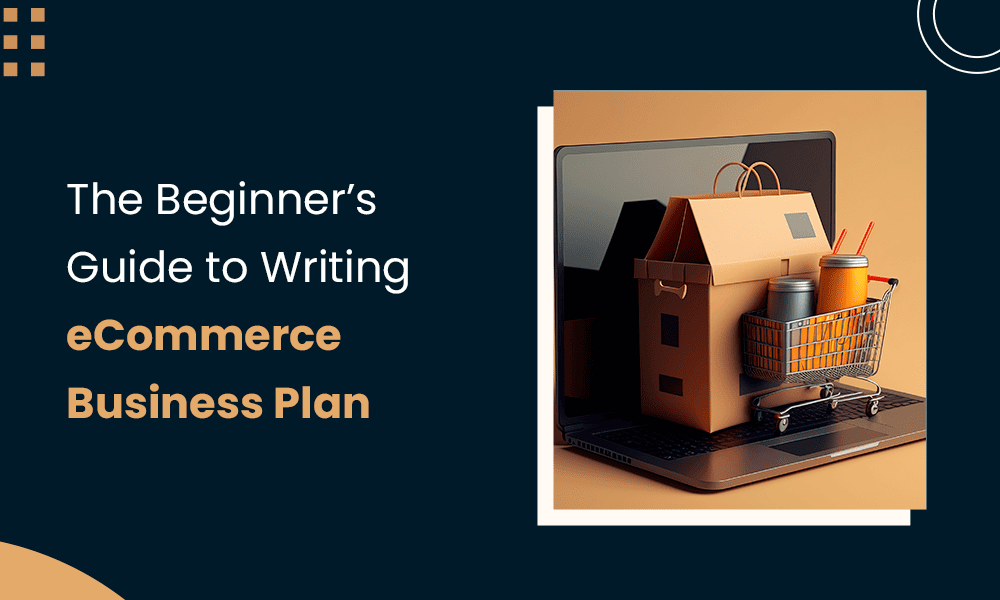In eCommerce, as in everything, you must have a business plan. However, sometimes, you might not be exactly sure where to start.
That’s where this little guide comes in. Ahead, we’ll share all the information you’ll need to create your own eCommerce business plan.
Table of Contents
How to Write Your eCommerce Business Plan

To write your eCommerce business plan, and when paired with a business plan template, it can streamline the process by providing a structured framework for organizing and interpreting data effectively you’ll need to cover the following topics.
1. Company Description
Your eCommerce business plan must begin with a company description.
Also referred to as a business description, a company description is a succinct summary of your business. It includes a little bit of background information on why your company exists, what you do, what your goals are, and why you’re unique.
A company description needn’t be stuffy, and there’s no need to write an overly long description either.
Keep in mind the company description isn’t a bio or about page. You can speak briefly about your company history, but spotlight that elsewhere.
6 High-Impact eCommerce Marketing Strategies to Try Now
2. Products
The next component of your eCommerce business plan is an overview of your products.
If you’re a services-based business, you can describe your services in just the same fashion. That also applies if you sell both products and services.
What products does your company currently have available? For each product in the roster, list it. There’s no need to go into tremendous detail on the products unless a short descriptor helps differentiate between them.
Next, do the same for your services as appropriate.
If your company knows you’ll soon release a new product or service, you can include that in your list.
eCommerce Metrics Made Easy: How to Drive Growth
3. Operations
Now it’s time to switch to the operations section. This might sound a little like the upcoming market analysis, but the two are different.
You want to spotlight your company’s goals and objectives in the operations section. More so, include the procedures you’re using to achieve those goals and objectives and the timeline you have for getting there.
17 Fab Ideas for eCommerce Business
4. Market Analysis
Market analysis is one of the most important components of any eCommerce business plan.
This ultra-detailed, thorough, in-depth market assessment dives deep into your industry to cull information such as competitors, customer buying behaviors and patterns, and market dynamics.
Let’s break down the various components of the market analysis.
Read also: 8 Game-Changing eCommerce Integrations For 4X Growth
TAM, SAM, and SOM – What You Need to Know
As you do a market analysis, you’ll see acronym after acronym. What in the world is a TAM, and how is it different from a SAM?
Let’s explain.
TAM stands for the Total Addressable Market. In other words, if you had no competition and the entirety of the market share, how much money would your company make? That’s the TAM.
Of course, no matter what kind of industry you’re in, competition exists. You use the TAM more for comparison purposes for your eCommerce business than for anything attainable.
Next, there’s your SAM or Serviceable Available Market. This refers to the existing market shares that your company can obtain.
What in your industry can you do different or better? Once you know that, you have your SAM.
We also have to talk about the SOM or Serviceable Obtainable Market.
The SOM represents the existing portion of your market that you can claim three to five years from now. Your SOM varies based on elements like product/service pricing, existing marketing strategies, and competition.
Using Industry Reports to Calculate TAM
Okay, so now that you’ve got your acronyms all straight, let’s talk about how to use them, beginning with TAM.
Remember, TAM represents how much money your company could make if no competition existed. Analyzing existing industry reports, you can gauge what that cash influx would look like.
👉Want to capitalize on your spare time? Find out about passive income apps to make extra cash in our comprehensive guide.
Using TAM to Calculate SAM
TAM is not a measure of anything realistic, but you can use TAM to calculate your SAM.
How do you do that? First, you want to select a target market. Be specific in your selection, and then gauge your TAM.
Next, take that number and multiply it by the annual revenue average per customer, and you’ve calculated your SAM.
How to Calculate SOM
Your market analysis must also include a SOM, which determines how your business can grow in the next three to five years.
Although no one can hold up a crystal ball and accurately guess what the future holds, reviewing the market size of your competitors will point you in the direction of your SOM.
B2B eCommerce Trends: These Strategies Can Boost Your Business
5. Marketing Strategy
Continuing with your eCommerce business plan, the next component of the plan is a full-fledged marketing strategy.
What kinds of promotions does your company require to meet its planned objectives? How long will a marketing campaign last, and how many campaigns will it take to meet your goals?
How much money will your marketing strategy cost in the short- and long-term? Does your company have the staff to pull off a viable marketing strategy, or will you have to hire new staff or even a third-party company?
If your marketing budget is tight, you should consider some of the most affordable marketing tools out there. EngageBay is a favorite among them.
19 eCommerce Best Practices to Win Customer Confidence
6. Financial Plan
To answer questions regarding the financial elements of your marketing plan–not to mention all the other financial elements of your eCommerce business plan as a whole–you must have all your financial ducks in a row.
You can do that with a financial plan. The plan will include at least five individual budgets that go into different areas of spending, from advertising to investing and everything in between.
More than merely listing these values, you should also determine how much capital you’d need to achieve a financial plan.
Ecommerce Marketing: 8 Areas to Focus on to Increase Sales
7. Milestones
What kinds of benchmarks are you trying to fulfill in your business journey? You’ll detail them all in the milestones section of the plan.
A milestone isn’t just any goal, but an attainable, achievable goal that pushes your projects and progress forward. You can list the milestones you plan to achieve and include a blueprint for getting there.
Top eCommerce Business Ideas for Aspiring Entrepreneurs [2024]
The Top-Down Approach
Business management generally boils down to two approaches, top-down or bottom-up. In this section and the next, we’ll explain both approaches and how they differ so you can select the most appropriate for your company.
Let’s begin with the top-down approach. This management approach requires a project or team manager to make the big decisions.
Those decisions then reach all the parties below the manager, where the various roles follow the instructions they’re given.
A project or team manager will review the success of the top-down approach and then adjust for better productivity based on how successfully the management model plays out.
Many offices and workplaces are quite familiar with the top-down approach, ensuring clear-cut communication, easier problem-solving, speedier implementation, and better following of the rules.
However, the top-down approach can also reduce creativity and cause team disengagement, so you don’t always see it used anymore.
7 Powerful eCommerce Marketing Automation Strategies + Tools
The Bottom-Up Approach
So what about the bottom-up approach?
This business management model involves a more collaborative, equal effort among teams. Offering a greater degree of flexibility, the bottom-up approach increases space for creativity.
Employees feel more valued and appreciated. Rather than being told what to do, they get to have a say in the decision-making. This in turn increases employee morale.
However, even the bottom-up approach has its disadvantages. The high-level insight often missing can cause teams to fall astray, making preventable mistakes that can cost a company a lot of money.
Leadership dynamics will naturally shift as someone or several people vie for a top spot. These leadership imbalances can cause momentum to drop and projects and planning to take longer than they should.
eCommerce Email Marketing Simplified: 15 Examples + Tips
Beta Testing and Proof of Concept
As your business plan comes together, the time will come for proof of concept. You’ll demonstrate your business idea and how it works to attract investors, donors, and more.
Beta testing and proof of concept allow you to gauge a work process or business plan’s viability before going live with it and possibly incurring negative consequences.
These tips will make the proof of concept stage seamless.
Incentivize Beta Testers
Why should someone take the time to beta-test your product or service? Give them something worth taking the time for! The more incentivizing the offer, the more volunteers you’ll naturally attract.
Read also: Unlocking Retail’s Next Chapter: D2C eCommerce Trends to Watch
Find Influencers to Beta Test Your Product
Another option is to win the acclaim of influencers. An influencer’s power and sway will inspire others in their audience to beta test your product.
You’ll also generate a lot of buzz and name recognition, which can come in handy ahead of a major product or service release.
Read also: eCommerce Customer Expectations: The Science of Delight
What Are the Four Types of eCommerce Businesses?
To wrap up, let’s review the four business models or types of eCommerce businesses.
B2C
The first is the standard business-to-consumer or B2C model.
As a business, you sell products or services directly to consumers or customers. Buying apples at the grocery store or a new pair of Nike sneakers online, those are two examples of B2C business.
B2B
B2B stands for business-to-business.
Rather than produce goods and services for consumers, a B2B model has another business in mind when designing the end product. For example, a medical supply company will sell products to a hospital.
Read also: The Beginner’s Guide To ECommerce Support Outsourcing
C2B
Then there’s the lesser-known C2B or consumer-to-business model.
In this model, a consumer provides something of value to a business. This needn’t be a product or service, per se, but can include reviews and testimonials.
C2C
Finally, there’s the C2C or consumer-to-consumer model.
Consumers will sell something to other consumers, usually through third-party websites or platforms such as Facebook Marketplace, Craigslist, or eBay.
Find the Perfect B2B Ecommerce Platform for Your Needs
Conclusion
An eCommerce business plan positions your company for success.
Whether in the B2B or B2C spheres, we hope the information in this guide helps you create your own actionable eCommerce business plan!


